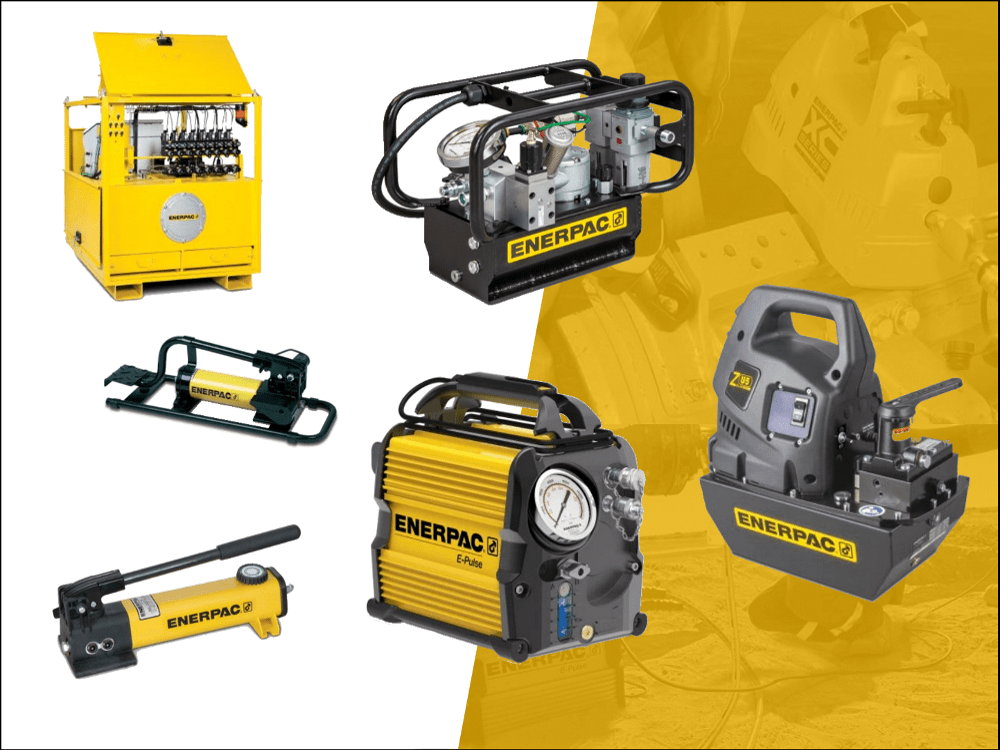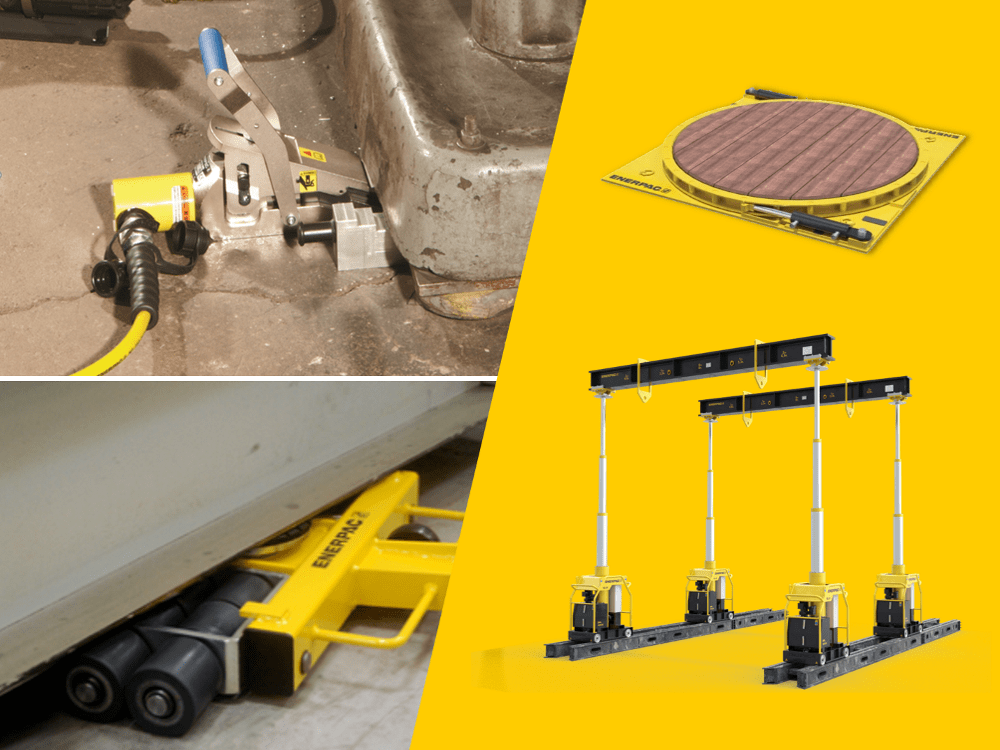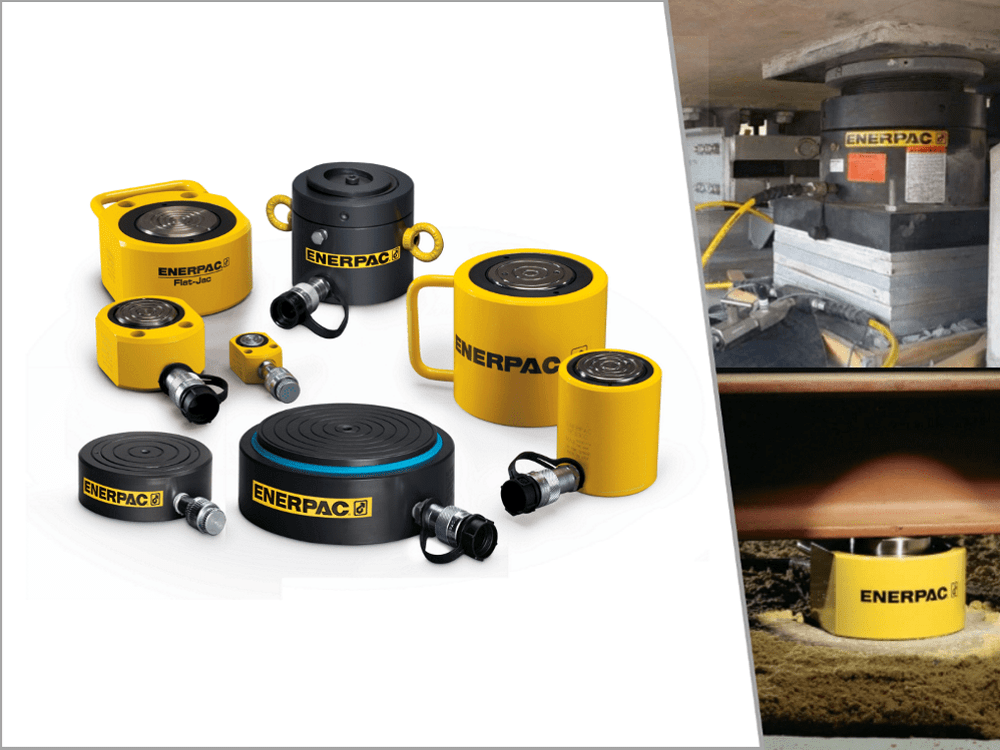Controlled Lifting Pumps for Infrastructure Projects: What are your Options?
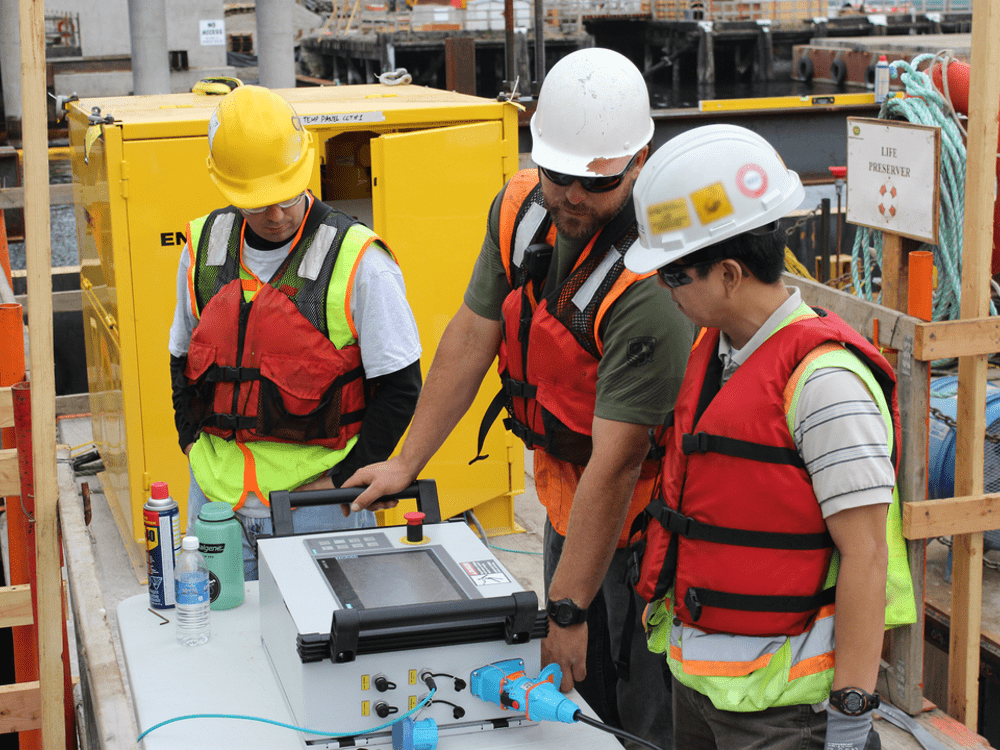
September 24, 2024
0
When an infrastructure project involves lifting a large component such as a bridge deck, the stakes are far too high to take shortcuts by using inappropriate equipment. If the project requires lifting and lowering applications from multiple points, a controlled lifting pump offers a far safer and more productive alternative to independently operated pumps.
In this article we explain what controlled lifting means, we compare the types of hydraulic systems currently available and their potential applications.
What are controlled lifting pumps?
Controlled lifting pumps provide controlled and synchronized flow to multiple lift points when lifting large and heavy items in the construction industry. They enhance the efficiency, safety, and reliability of lifting operations, making them an invaluable tool for modern construction projects.
The benefits can be summarized as:
Precision and Accuracy: Providing precise positional control is crucial for complex construction tasks that require exact alignment and placement of components.
Enhanced Safety: By maintaining uniform lifting and lowering operations, these pumps reduce the risk of accidents caused by unbalanced loads or uncoordinated movements. This contributes to a safer work environment for construction workers.
Increased Productivity: The automation and synchronization of lifting tasks minimize the need for manual interventions, speeding up operations and increasing overall productivity.
Structural Integrity: Controlled hydraulic systems distribute loads evenly across multiple lifting points, reducing stress on individual components – especially those using programmable logic controls to monitor and control each lifting point. This is especially important for projects involving heavy or irregularly shaped loads.
Versatility: These pumps can be used for a wide range of applications, from lifting large steel structures to precisely positioning prefabricated concrete bridge sections. Their adaptability makes them valuable for various construction projects. Controlled lifting pumps can have the capacity for multi-point lifting using hydraulic cylinders with capacities of up to 500 tons.
Cost-Effectiveness: Although the initial investment in controlled hydraulic lifting pumps seem high, the long-term benefits of increased efficiency, reduced downtime, and lower maintenance costs make them a cost-effective choice for construction companies.
Controlled lifting pumps are often used with the following types of heavy lifting equipment:
- High-Tonnage Cylinders – for a diverse range of projects, including replacing bridge bearings.
- Cube Jacks– for various lifting projects, for example, when using SPMTs (self-propelled modular transporters).
- Sync Hoists – for synchronous positioning below the hook on cranes.

Applications for Controlled Lifting Pumps
As the list below shows, controlled lifting pumps are not only used for infrastructure projects, they’re also used in other industries
- Building repairs and stadium construction
- Positioning tunnel boring machines
- Lifting bridge decks and abutments
- Installing or removing transformers, boilers, presses
- Mining equipment maintenance
- Upgrading large cranes and ship loaders
- Shipbuilding
Types of Enerpac Controlled Lifting Pumps
Split Flow Pumps
Where synchronization of maximum 4% is acceptable, Split Flow Pumps provide a safe and economical solution. (This is an improvement on the 10% variance between lift points when using a basic split flow manifold). Flow to each outlet is controlled via simultaneous operation of valves from a handheld pendant to provide even flow to each lift point regardless of differences in load. As long as all cylinders have the same load rating (effective area), the cylinders will move evenly based on this even output flow.
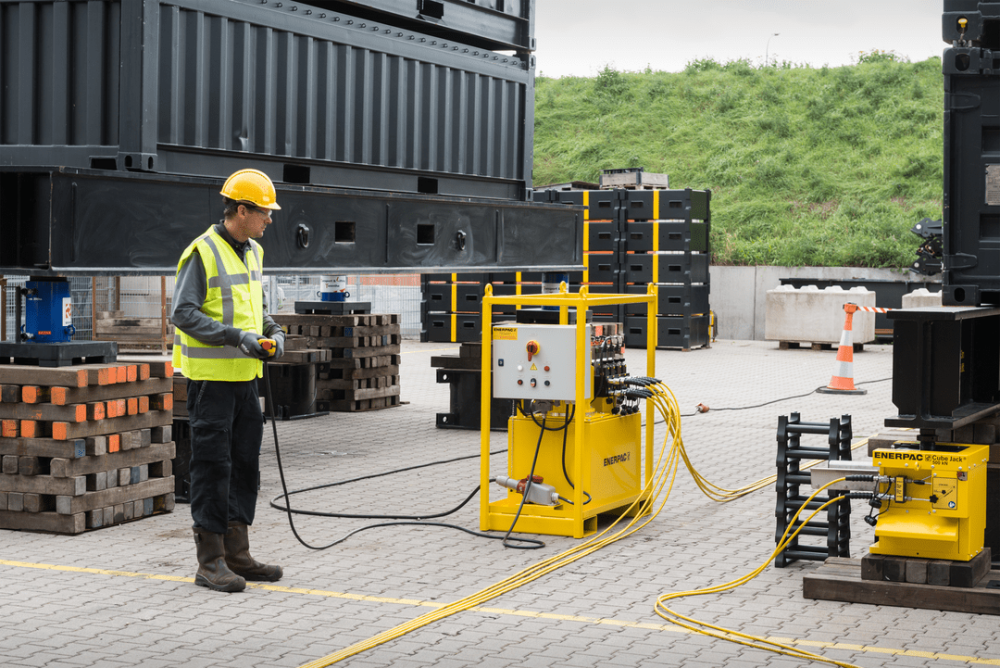
These pumps feature both single and synchronized multiple outlet control either through joystick or pendant operation. For fine-tuning at individual lift points, valves can be controlled individually.
Limitations are that visual feedback is needed to control the lift operation and variations in load per lift point require care to balance and position load.
Split flow kits can be upgraded, which is covered later in this article.
EVO Synchronous Lifting Pumps
When greater accuracy is needed, an EVO System can provide this by delivering an accuracy of 0.040 inches (1 mm) between lifting points. The system also offers advanced features, such as an intuitive user interface, several flow options, and built-in warning alarms. They use a PLC (Programmable Logic Controller), and all movements are managed from a central control position that displays live operation with real-time status updates.
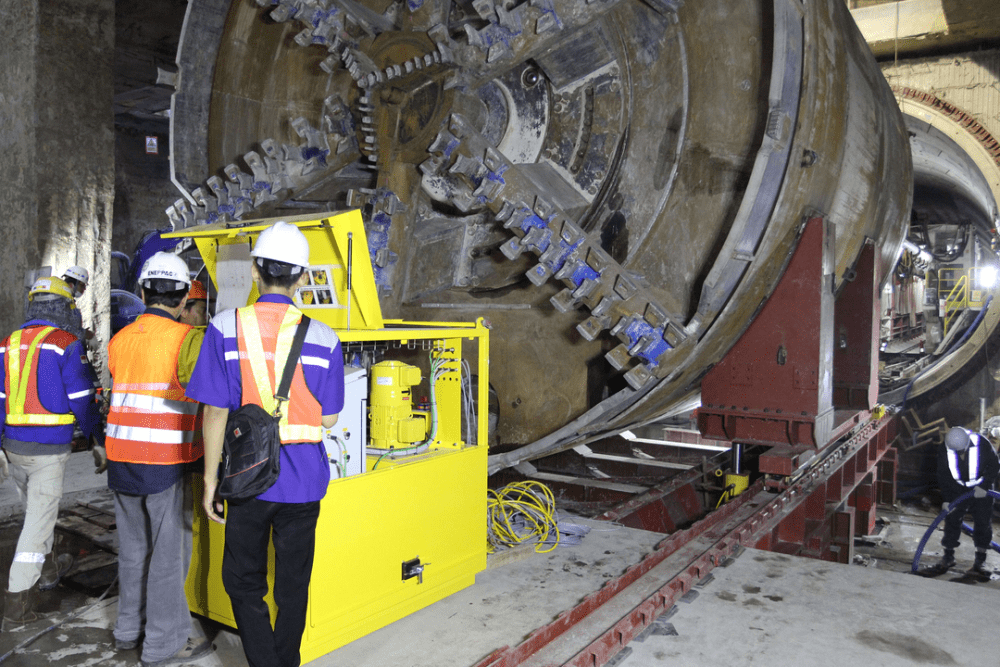
Multiple pumps can be networked together to control up to 48 total lifting points from a single operator control station.
The only potential downsides are that reservoir size can be excessive for many applications and using a single pump unit can require longer hoses to reach remote lifting points.
Pump Per Point System (EVOP)
When high flow is required, such as when using long stroke cylinders and repetitive operations such as with climbing jacks, EVOP-Series pumps provide the best combination of high flow rate and accuracy. Unlike the split flow and EVO pumps, each controls only one lifting point.
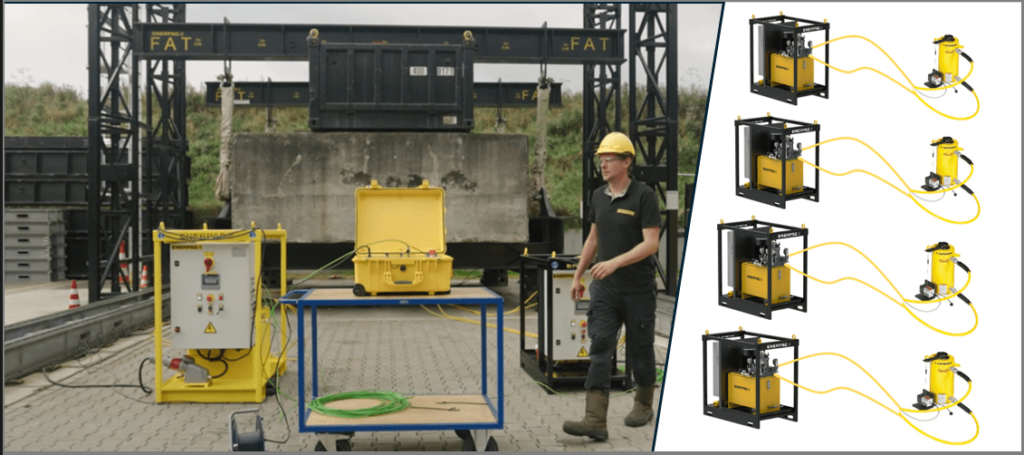
Can the pumps at each point be synchronized? Yes, synchronization is controlled via a variable frequency drive (VFD) on the motor, which enables smooth and accurate operation at high lifting speeds.
These pumps are ideal for high-tonnage cylinders, 300-1000 ton capacities and multiple pumps can be networked together to control up to 12 total lifting points from a single operator control station.
Split Flow Pump Upgrade Kits
Standard Enerpac split flow pumps provide constant oil flow to each lift point, providing consistent movement of each cylinder. With the upgrade Kits, users can get more value and expand the flexibility expand of their equipment by extending the number of lift points, increasing the accuracy of existing systems, and controlling the entire lifting process from the convenience of a single interactive touch screen.
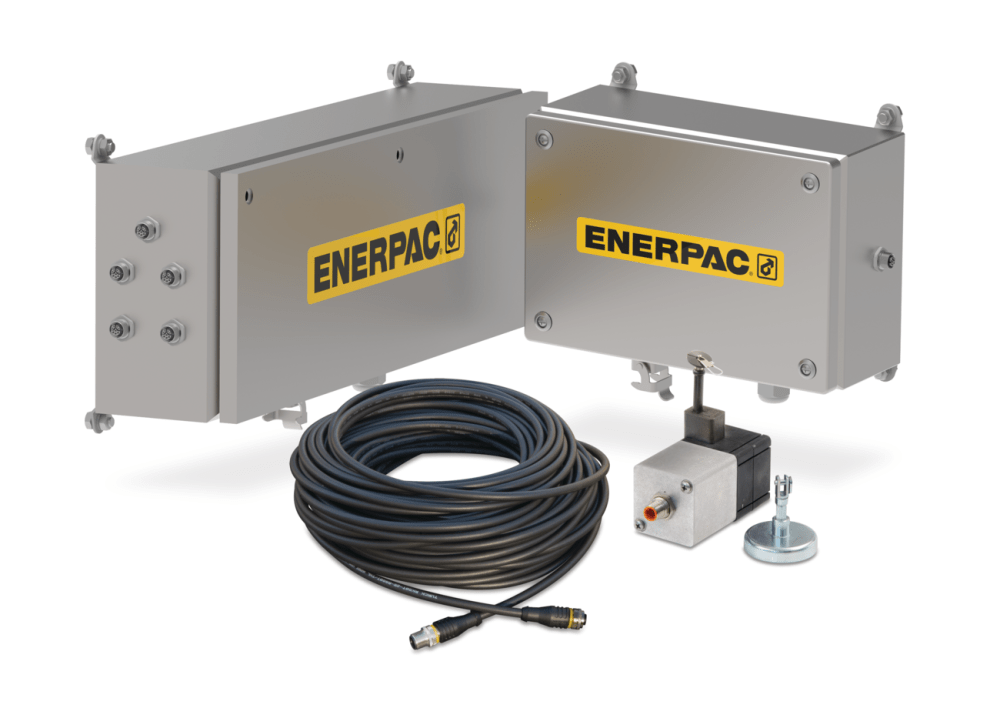
There is a choice of three upgrade kits:
- Network Kit: Depending upon the model, standard Split Flow Pumps lift using 2,4,6, or 8 points. The Network Kit increases the number of lifting points by connecting several SFP together (maximum of 32 lift points) and controls them from a single control station.
- Synchro Kit: This synchronizes the lifting points of a single Split Flow Pump through use of feedback from stroke and pressure sensors as used in the EVO pumps.
- Multiple SFP Synchro Kit: Combines the advantages of both options described above: Connects several SFP together and synchronizes all the lifting points to within 0.04 inch (1.0 mm) using stroke and pressure transducers.
Controlled Lifting Pumps Compared
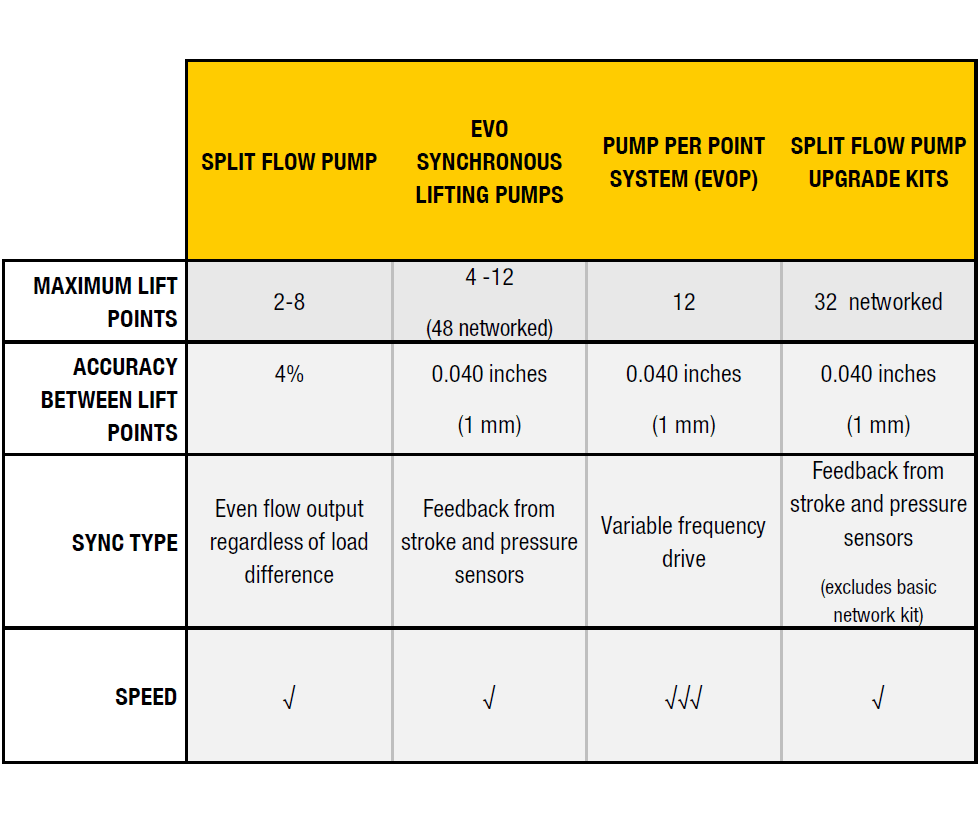
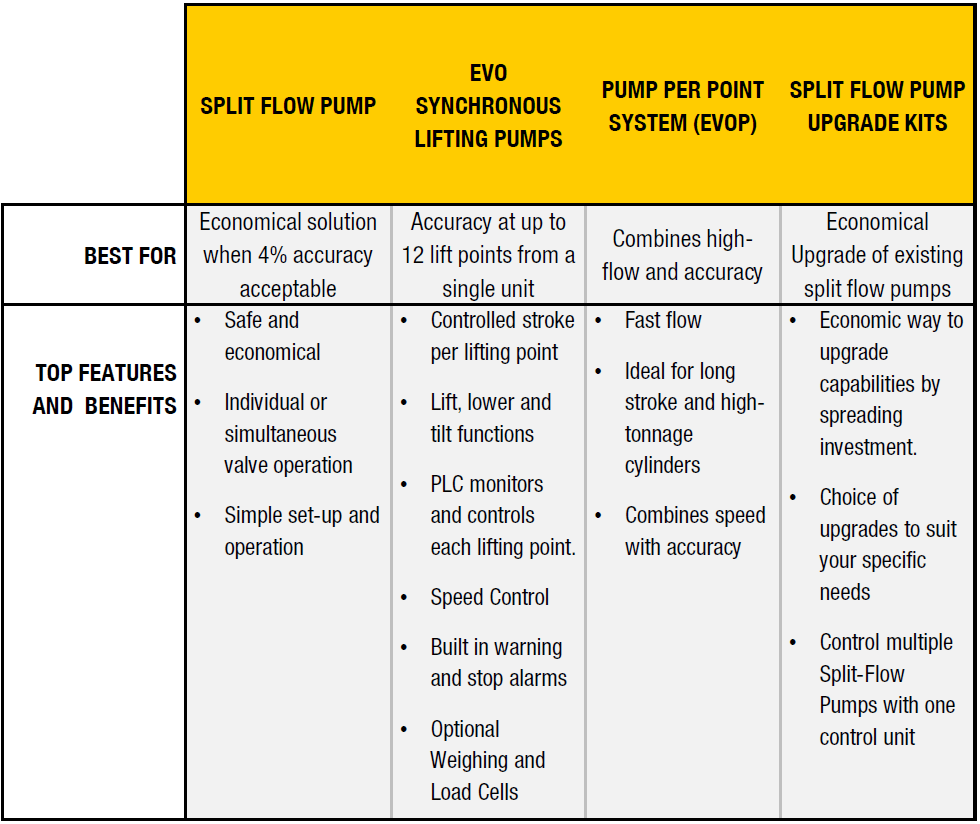
Buyer’s Checklist
When choosing a split-flow hydraulic pump, there are several key considerations to ensure the pump meets the specific needs of your application. These include:
- Flow Rate and Pressure Requirements: Determine the required flow rate and pressure for your application. Ensure the pump can provide the necessary hydraulic power to operate efficiently under these conditions.
- Number of Outputs: Assess the number of outputs or circuits the pump can handle. Choose a pump that can accommodate the number of lift points or hydraulic tools you need to operate simultaneously.
- Synchronization Capabilities: Evaluate the pump’s ability to synchronize flow to multiple outputs. This is crucial for applications that require precise control and coordination between multiple lifting points or hydraulic cylinders.
- Control Features: Look for advanced control features such as electronic synchronization, automatic load balancing, and pressure regulation. These features can enhance the accuracy and safety of your hydraulic operations.
- Compatibility with Existing Equipment: Ensure that the pump is compatible with your existing hydraulic systems and components. This includes checking the compatibility of fittings, hoses, and control interfaces.
- Support: Choose a pump that’s easy to maintain and service. Consider the availability of spare parts, the complexity of repairs, and the support provided by the manufacturer.
- Mobility and Portability: If your application requires frequent movement of the pump, consider its size, weight, and portability. A compact and lightweight design can be advantageous for mobile operations.
- Safety Features: Look for safety features such as overload protection, emergency stop functions, and safety valves. These features can prevent accidents and protect both the equipment and operators.
- Cost: Consider the overall cost of the pump, including the initial purchase price, installation costs, and long-term operating expenses. Balance the cost with the benefits and features offered by the pump. If you want to spread the cost you may want to start with a split flow pump and upgrade when the need arises.
- Manufacturer Reputation and Support: Research the reputation of the pump manufacturer. Choose a manufacturer known for producing high-quality, reliable hydraulic equipment and providing excellent customer support.
- Application-Specific Requirements: Consider any specific requirements of your application, such as the need for explosion-proof components in hazardous environments or corrosion-resistant materials for use in harsh conditions.
Summary
Controlled lifting pumps are vital for infrastructure projects, offering precision, safety, and efficiency. They ensure synchronized flow to multiple lift points, reducing risks from manual interventions and unbalanced loads. Their uniform lifting enhances productivity and safety, making them essential for complex tasks requiring precise alignment.
Choosing the right pump involves considering flow rate, pressure, number of outputs, synchronization, and control features. You should also consider compatibility with existing equipment, ease of maintenance, and safety features.
Consult the Experts
A controlled lifting pump is an important investment, and the demands of projects can vary hugely. While we hope the information in this article gives some initial insight, we recommend getting in touch with an Enerpac Heavy Lifting specialist, who will guide you to the right decision, and provide support from initial purchase throughout the complete ownership experience.
